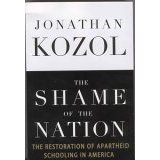The Shame of the Nation
 |
|
| Author | Jonathan Kozol |
|---|---|
| Country | United States |
| Language | English |
| Genre | Nonfiction |
| Publisher | Random House |
|
Publication date
|
September 13, 2005 |
| Media type | Print (Hardback & Paperback) |
| Pages | 416 pp |
| ISBN | |
| OCLC | 58789392 |
| 379.2/63/0973 22 | |
| LC Class | LC212.62 .K69 2005 |
The Shame of the Nation: The Restoration of Apartheid Schooling in America is a book by educator and author Jonathan Kozol. It describes how, in the United States, black and Hispanic students tend to be concentrated in schools where they make up almost the entire student body.
Kozol visited nearly 60 public schools in preparation for writing the book. He found that conditions had grown worse for inner-city children in the 50 years since the Supreme Court in the landmark ruling of Brown v. Board of Education dismantled the previous policy of de jure segregated schools and their concept of "separate but equal". In many cities, wealthier white families continued to leave the city to settle in suburbs, with minorities comprising most of the families left in the public school system. In the book Kozol quotes Gary Orfield of the Harvard Graduate School of Education, who says, "American public schools are now 12 years into the process of continuous resegregation. . . . During the 1990s, the proportion of black students in majority white schools has decreased . . . to a level lower than in any year since 1968." In a separate quote from Gary Orfield in a letter to AllArtsAllKids.org, he mentions that, "the country clearly has had enough of the drill, kill, test & punish, and learn only two subjects style of NCLB reform... ".
In his earlier books, like Amazing Grace, Kozol wrote that the schools of the South Bronx were stunningly segregated. But in the last five years, Kozol said that he "... realized how sweeping this change has been throughout the nation, and how reluctant the media is to speak of it." Newspapers he says "... refuse to see what is in their own front yard ... in a description of a 98 percent black and Latino school, the newspaper won't say what would seem to be the most obvious starting point: This is a deeply segregated school. They won't use the word 'segregated.'"
In the book, Kozol attacks the disparity in expenditures on education between central cities and well-to-do suburbs, and the system of property taxes which most school systems and states rely on for funding. He expresses outrage at inequities in expenditure, pointing out that New York City in 2002-3 spent $11,627 on the education of each child, while in Nassau County, the town of Manhasset spent $22,311, and Great Neck $19,705. He found that there are comparable disparities in other metropolitan areas, since most funding is locally based. Kozol describes schools that are separated by a 15-minute drive but that offer vastly different educational opportunities. In one example, a primarily white school offers drama club and AP classes, and the nearby primarily black school requires classes like hairdressing.
...
Wikipedia
